OneStream in The Gartner Magic Quadrant for Financial Planning Software
OneStream named a leader in the 2024 Gartner Magic Quadrant for Financial Planning Software
FINANCIAL PLANNING SOFTWARE
OneStream in The Gartner Magic Quadrant for 2024
Financial planning software facilitates FP&A transformation and covers planning, budgeting, forecasting, modeling, performance reporting and agile insights. FP&A leaders can use this research to assess vendors best suited to offer technology solutions for their FP&A processes.
Market Definition/Description
Gartner defines financial planning software as the key tool that enables better decision making and resource allocation by supporting planning, budgeting and forecasting processes. It connects relevant operational and driver data to profit and loss, balance sheet and cash-flow financial statements. The software offers enhanced decision support and analytics that can be customized to unique planning requirements through data integration, data modeling, workflow and reporting capabilities. These capabilities all enhance a user’s ability to effectively manage the planning process and financial performance.
Organizations use financial planning software to improve financial planning and decision-making processes. These solutions streamline planning, budgeting and forecasting processes by providing visibility to planning data, consistent application of logic and planning process governance. When implemented in support of sound processes, financial planning software gives organizations reliable outputs to make better-informed decisions. This results in improved end-to-end financial planning processes, including aligning strategic priorities with resource allocation to drive improved business outcomes.
Common use-case scenarios or business problems addressed by financial planning tools:
Low complexity
This involves automating and streamlining planning processes by eliminating time-consuming and error-prone manual data-gathering processes. It also involves integrating various data sources and enhancing collaboration to minimize the administrative non-value-added burden historically associated with planning processes. Collaboration features allow planners to enter data simultaneously, resulting in greater confidence in the inputs and outputs used to make decisions.
Improved Operational Visibility
This applies to providing insights into key financial and operational performance metrics such as revenue, expenses and profitability. By having this information readily available, organizations are better equipped to assess and provide actionable insights based on the entirety of their data assets. Users can identify areas where improvements can be made to increase efficiency and drive value creation for the organization.
Global Complex Business Environment
This encompasses facilitating data integration approaches, modeling and analytics capabilities to organizations with high process complexity, and a high degree of and varied data granularity. This is typically applicable to enterprises with multiple business lines, diverse ERP systems, charts of accounts, and global or varied operational landscape with customer bases across the world.
Must-Have Features
Financial planning budgeting and forecasting
Enables financial planning, budgeting, and forecasting through user-driven models, customizable planning dimensions and enterprise-wide aggregation.
Administration functionality
Facilitates the management of planning activities through functionalities like prepopulated planning cycles, modifiable business rules, dimension maintenance and user-role-based security profiles.
Data integration
Integrates with ERP, CRM, human capital management (HCM) and other data sources to ensure accurate and unified enterprise-wide planning.
Financial planning and analysis reporting
Generates and allows users to create financial reports in standardized and customized formats providing insights for informed decision making.
Common Features
Scenario modeling
Offers features for creating and simulating various financial and operational scenarios by adjusting key variables helping organizations analyze the impact of these changes on their organization’s financial performance.
AI-powered planning
Leverages machine learning to forecast future financial performance, detect hidden patterns and anomalies in data, streamline analysis and data cleansing processes, and pinpoint areas for improvement.
Approval workflows
Streamlines budget and expenditure approvals with designated approvers in user-predefined workflows, ensuring proper oversight and minimizing unauthorized spending. It also supports online forms and electronic signatures for streamlined approval processes and provides the capability to track the approval history of documents.
Built-in audit trails and versioning
Offers features for tracking system activities, such as data entries and changes and aiding in the continuous monitoring of data and model evolution throughout the planning cycle.
Dashboarding
Offers customizable dashboards for a comprehensive view of financial health, as well as key metrics and key performance indicators to help drive operational insights.
2024 Gartner Quadrants for Financial Planning Software
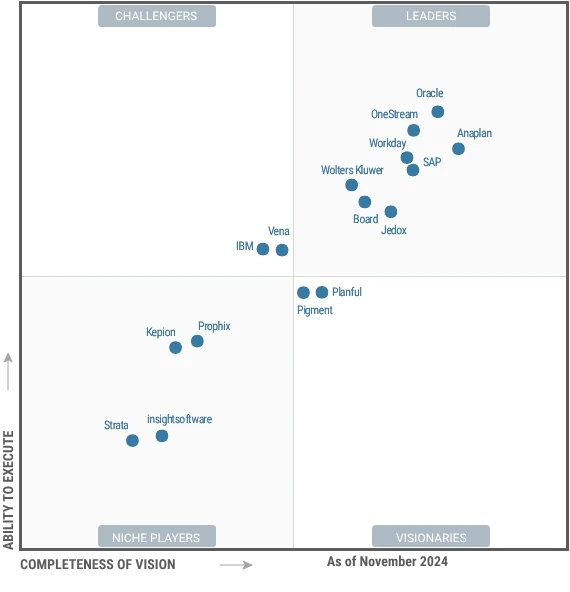
Vendor Strengths and Concerns
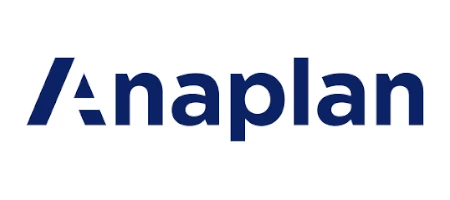
Anaplan for Financial Planning Software

Anaplan is a Leader in this Magic Quadrant. Its product, the Anaplan platform, offers a cloud-native platform for integrated business planning, budgeting and forecasting, with real-time connectivity in a unified user experience. Core to Anaplan’s architecture is its patented calculation engine, Hyperblock, which enables rapid calculations, multidimensional modeling, and ad hoc scenario creation, important for scalable data-driven decision making in dynamic industries.
Anaplan’s ability to support complex financial, operational supply chain and merchandise financial planning is evident in its significant manufacturing client base; however, it also has representation across a broad spectrum of verticals, notably CPG and retail.
Strengths
- Integrated business planning: Anaplan supports IBP with extensive use cases, connecting strategic, financial, operational and external data to support planning across finance, supply chain, sales, marketing and human resources. It empowers customers to implement a connected planning process on a single platform, enabling decisions with increased speed, collaboration and agility.
- Data validation: Anaplan automates data validation with advanced capabilities such as real-time validation rules, detailed error reporting and dashboards used to take timely action on exceptions. This reduces the time clients must spend on manual data validation.
- Predictive analytics transparency: Anaplan offers advanced predictive analytics functionality, featuring “explainability” and “impact scoring” to help users understand forecast drivers and interpret how variables impact forecast accuracy.
Concerns
- Available license visibility: Anaplan’s product lacks native visibility into user and license counts within the administration portal, limiting an administrator’s ability to ensure compliance with the software licensing agreement. This functionality was on the product roadmap last year and is still scheduled to be delivered. Customers that frequently shift licenses or manage costs may struggle to audit assigned user licenses.
- Market responsiveness: Anaplan executed most of its planned roadmap features, but some features, like workflow automation, are industry standard. The acquisition of Fluence Technologies expanded its focus from FPS enhancements to integrating a close and consolidation solution within its wider product offering. Clients should evaluate the vendor’s roadmap for FPS alignment during this integration to ensure it doesn’t distract from FPS market needs.
- Accessibility standards: Anaplan’s accessibility features include customizable colors and typefaces for readability and keyboard navigation for users with visual impairments. It has achieved the basic level of conformance with internationally recognized accessibility standards like WCAG. Clients with deeper accessibility requirements, like higher contrast ratios, text resizing or comprehensive error suggestions, should inquire about the vendor’s standards.

Board for Financial Planning Software

Board is a Leader in this Magic Quadrant. Its product, also called Board, integrates planning processes in a single platform, offering strategic, financial and operational planning with real-time analysis and data sharing. A key innovation is its generative AI agent, which assists FP&A teams with natural language requests to support data integration, forecasting and reporting. This approach helps streamline daily tasks — useful for companies that want to enhance operational efficiency.
Board’s capability to support comprehensive FP&A through an IBP solution developed with Oliver Wight, enhancing holistic business management, is evident in its significant manufacturing client base; however, it also has representation across all major industries.
Strengths
- Product development: Board employs a comprehensive R&D approach, including customer advisory boards (CABs), the Board LABS program, and product usage analytics to gather and respond to customer needs. This structured feedback is crucial for developing products that meet market demands. Clients should ask to participate in these mechanisms to ensure their needs are addressed in future updates.
- Data processing: Board’s proprietary in-memory engine (HBMP) ensures consistent performance and optimizes data processing with AI-based automatic sparsity management. This enables efficient data handling, essential for agile data analytics. Clients can expect improved performance and faster insights, driving better decision making.
- Data integration: Board integrates with many major systems through certified APIs. This capability ensures smooth data flow across platforms, enhancing operational efficiency. To maximize these benefits, clients should evaluate their current systems and plan for integration to streamline their operations.
Concerns
- Starter kits: Board offers starter kits covering typical FP&A use cases, including data connectivity, models, procedures, calculations, security and reporting. However, the range of these kits is limited to foundational finance processes and lacks a broader marketplace for sharing kits. Clients should evaluate their needs and consider custom development if necessary.
- Predictive analytics: External drivers are not natively included within Board’s platform but are incorporated through REST APIs. Users may need to set up and configure these integrations themselves, requiring additional effort and technical expertise. Clients lacking in-house technical resources could face challenges, so they should assess their technical capabilities and plan for potential integration efforts.
- Pricing: Board’s pricing structure involves multiple add-ons with varying costs, indicating a high degree of ad hoc pricing and potential hidden costs. The extensive list of additional components, such as connectors, sandboxes, predictive analytics and premium support, may lead to complexity and unexpected expenses for customers.
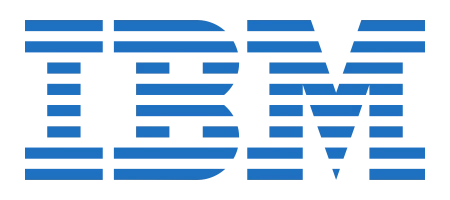
IBM for Financial Planning Software

IBM is a Challenger in this Magic Quadrant. Its product, IBM Planning Analytics, is a configurable platform for financial and operational planning, featuring an in-memory TM1 calculation engine for high-performance processing. A key innovation is its AI-powered multivariate forecasts, which identify impactful variables and simulate scenarios, helping companies develop robust strategies in dynamic markets.
IBM’s ability to efficiently handle extensive workloads ensures high performance and reliability for SKU planning, matrix reporting and product profitability, evident in its significant retail client base. It also has representation across all major industries.
Strengths
- Pricing transparency: IBM offers a pricing calculator on its website to estimate costs based on user numbers and RAM usage. This transparency helps clients make informed decisions about the cost of the platform, building trust and reducing financial uncertainty. Clients should use this tool to estimate the cost and help avoid unexpected charges.
- Capacity: IBM Planning Analytics uses a 64-bit architecture and in-memory TM1 engine, supporting complex models and large data volumes for system stability and flexible cloud deployments. Clients can leverage strong data processing engines to handle large-scale operations efficiently while maintaining high productivity.
- Global compliance: IBM has robust privacy and data protection obligations for third-party partners, including comprehensive training and detailed principles. It holds multiple operational and organizational certifications, ensuring compliance with various quality standards. Customers can rely on IBM to meet regulatory requirements and maintain secure global operations.
Concerns
- Product strategy: IBM’s planned enhancements focus on expanding PA for Microsoft Excel, generative AI for variance analysis and recommendations, and deeper integration with IBM Controller. While these updates aim to improve a complete enterprise performance management and user experience, they lack groundbreaking features to distinguish IBM from the market. Clients seeking the latest features should evaluate whether IBM’s roadmap meets their needs.
- API connectors/data integration: IBM offers fewer out-of-the-box connectors for ERP and non-ERP systems compared to other market options, which offer a wider range of connectors. Most data connections are deployed as ODBC drivers, including Microsoft SQL Server, Oracle Database, and Snowflake. Clients should use relational database connections and assess the need for extra resources to develop and maintain custom integrations.
- Implementation partnership: IBM does not provide monitoring or oversight of partner-led implementations, which may result in inconsistent quality and success of implementations. Clients will need to set up a clear escalation path with the vendor for critical issues that arise during implementations, ensuring the process for seeking assistance is well-defined
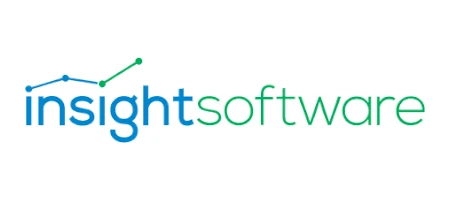
InsightSoftwarefor Financial Planning Software

insightsoftware is a Niche Player in this Magic Quadrant. Its product, Bizview, offers web-based budgeting, planning and forecasting with an Excel-like interface and self-service reporting, dashboards and analytics. A key innovation is its open business data fabric, which connects data integration with planning and reporting tools, a useful feature for companies seeking efficient planning and reporting solutions.
insightsoftware’s ability to integrate data from various sources, providing a unified view of operations that enhances decision-making and operational efficiency, is evident in its significant technology client base. Additionally, it focuses on select industries with specialized vertical emphasis.
Strengths
- Data integration: insightsoftware provides prebuilt connectors to ERPs common among midmarket firms, such as Xero, Deltek and VantagePoint, along with data import options via flat file, API and VPN. It also supports larger ERPs like Oracle and SAP. Clients should leverage these integrations to streamline data flow, enhance operational efficiency and expedite implementations.
- Product development: insightsoftware’s product strategy is informed by customer feedback and market inputs, ensuring developments align with client needs and industry trends. Contributions from a customer advisory board and market research shape the M&A strategy, blog posts, webinars and product roadmaps. Clients should participate in these channels to ensure their needs are addressed.
- Workflow automation: insightsoftware enhances collaboration with workflow comments, chat, email notifications and document uploads. The administrative dashboard shows live workflow status to identify and fix roadblocks. Clients aiming to improve planning efficiency should use these features to boost collaboration and their overall process efficiency.
Concerns
- Implementation partnership: insightsoftware does not provide monitoring or oversight of fully partner-sold implementations. This lack of oversight could lead to inconsistent quality and success in implementations. Clients will need to ensure their partners have robust processes and maintain close collaboration with the vendor to mitigate implementation risks.
- Starter kits: Some of insightsoftware’s industry starter kits are partner-specific, which can lead to increased configuration requirements and slower implementations. Users should evaluate whether the vendor’s offerings meet their specific needs and consider potential additional implementation costs.
- Integrated planning: insightsoftware lacks prebuilt applications for financial planning processes such as cash forecasting and capital planning, or operational use cases such as demand, supply, workforce and inventory, which must be configured or coded. Potential customers should investigate potential implementation costs and conduct a cost-benefit analysis of custom configurations versus prebuilt solutions.
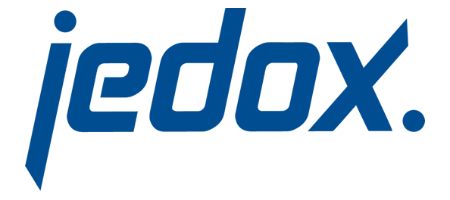
Jedox Financial Planning Software
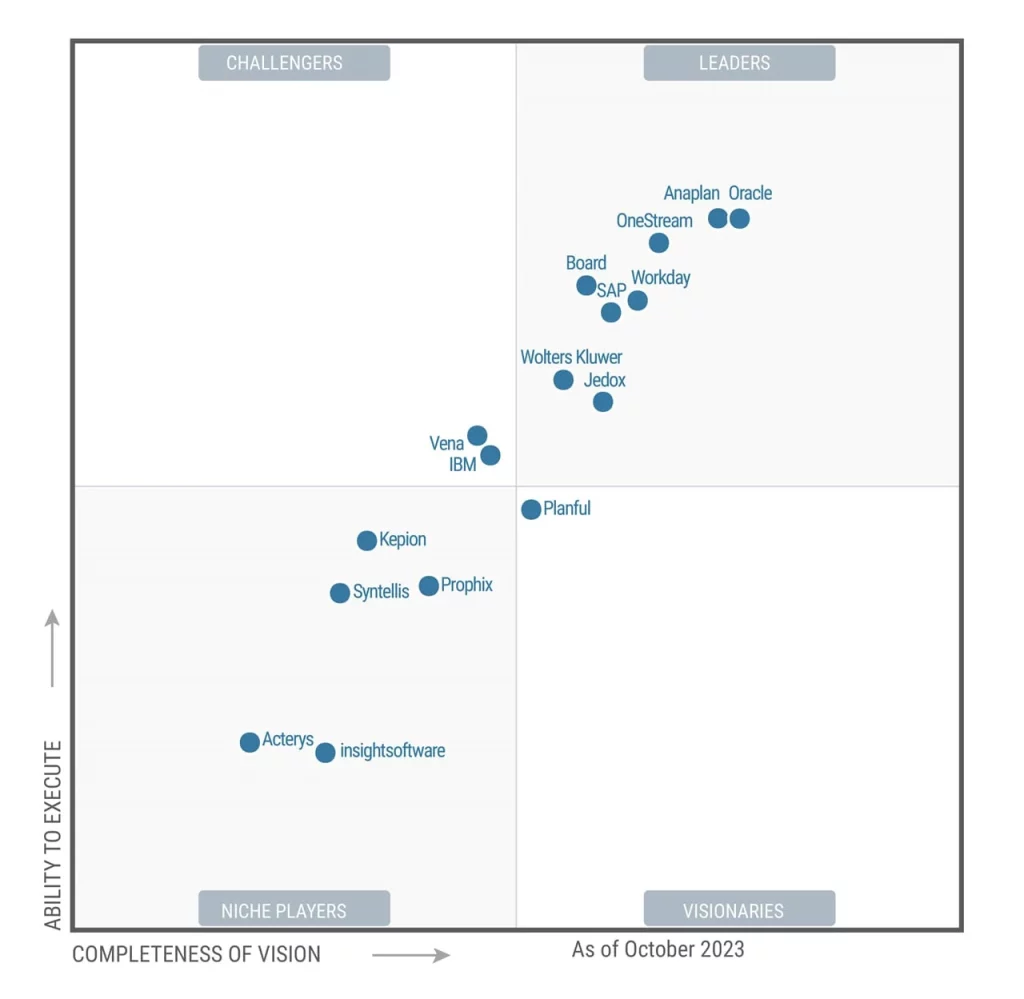
Jedox is a Leader in this Magic Quadrant. Its product, Jedox EPM software, is a planning and performance management platform for budgeting, forecasting and reporting with AI, an in-memory database and customizable prebuilt models. A key innovation is its AI-powered automated report generation from natural language input. These capabilities are beneficial for clients seeking to accelerate insights and empower FP&A professionals to focus on strategic tasks.
Jedox’s ability to support strategic and operational planning through best practice accelerators and adaptable templates specifically for IBP use cases is evident in its significant manufacturing client base; however, it also has representation across a broad spectrum of verticals.
Strengths
- Master data management: Jedox offers MDM capabilities through Jedox Integrator, a free tool for transforming and validating data against customer-defined governance rules. Changes are tracked, enabling an automated and auditable data validation process. Clients aiming to enhance data governance and operational efficiency will find these capabilities can streamline data management and increase accuracy.
- Pricing: Jedox offers a thorough and transparent pricing model. It starts with a platform foundation and number and type of users, while allowing a la carte add-ons for best practice accelerations and connectors. Clients benefit from the ability to accurately assess costs and select relevant add-ons for their planning needs.
- Geographic expansion: Jedox has established new strategic partnerships across various regions, including the U.S., Canada, South America, APAC and the Middle East, to expand market reach, with initiatives like the Jedox Elevate Roadshows and targeted event sponsorships enhancing customer engagement. Customers should leverage these events and partnerships to gain insights into Jedox’s product vision.
Concerns
- Starter kits: Jedox does not provide industry starter kits directly, but connects customers with partners who have industry-specific knowledge and success records. Customers needing software tailored to their industry should do additional research on Jedox’s partners to ensure the partner-led approach will meet their industry-specific needs.
- Capital planning: Jedox lacks out-of-the-box capital planning capabilities, instead requiring configuration or coding. The configured functionality focuses on asset tracking, which may be challenging for those with a project-based approach to capital. Organizations with numerous or complex capital budgets should evaluate the software’s ability to meet requirements and the configuration impact on implementation.
- Implementation partnership: Jedox’s approach to partner-led implementations is reactive and does not take a fully data-driven or proactive approach to monitoring. While it provides customer success managers as standard support, more proactive success monitoring is available for a fee. Clients should discuss implementation expectations with the vendor and its partners to ensure alignment and identify support gaps.

Kepion Financial Planning Software

Kepion is a Niche Player in this Magic Quadrant. Its product, Kepion FP&A Essentials, provides cloud financial planning and analytics with real-time data and analysis, and Microsoft tools, including Azure and Power BI. A key innovation is its data hub and data rules designer, which connect to source data, data management and business rule creation without coding, an advantage for companies seeking flexible, self-managed and tailored planning solutions.
Kepion’s ability to support demand planning, inventory/supply planning, and sales and operations planning (S&OP) is evident in its significant manufacturing client base; however, it also has representation across all major industries.
Strengths
- Configurable models: The Kepion Modeler enables modeling of complex planning scenarios without coding, emphasizing finance self-dependence. Preconfigured solutions and a guided UI reduce IT dependency, adding efficiency and autonomy. Clients wanting to reduce their reliance on IT for modeling capabilities will benefit from these features.
- Implementation partnership: Kepion governs implementations with project scoping, satisfaction surveys and innovative tactics like telemetry optimization and partner royalties aligned with maximizing platform value. These tactics align vendor, customer and partner interests, increasing the likelihood of customer success. Clients find these strategies maximize the value of their implementation efforts.
- Global Infrastructure: Kepion’s solid presence in APAC, EMEA, LATAM, and NA is supported by deployments in local Azure data centers, ensuring reliable service across numerous active data centers in multiple regions. Clients seeking well-distributed global infrastructure and optimized data center utilization will benefit from these features.
Concerns
- Innovation: Keopion’s new features lag behind market offerings such as MS Office and Power BI integrations, which are industry standard. While these updates improve user experience, they do not introduce groundbreaking features that significantly differentiate it in the market. Clients seeking the latest features should evaluate whether Keopion’s roadmap meets their needs.
- Intelligent features: Kepion offers a support knowledge base and best practice links within the user interface, but lacks interactive generative AI capabilities for activity-based suggestions and model building. Clients with complex modeling needs should assess if lack of activity-based suggestions and generative AI impacts their efficiency and consider supplementary tools to bridge this gap.
- Customer support: Kepion provides 9 a.m. to 6 p.m. support five days a week; 24/7 customer support requires a premier subscription. Clients should assess their need for weekend and global support to ensure alignment with Kepion’s offerings for uninterrupted operations.

OneStream Financial Planning Software

OneStream is a Leader in this Magic Quadrant. Its product, the OneStream platform, supports corporate planning processes, including data management, planning, forecasting, reporting and analytics. A key innovation is its Extensible Dimensionality, allowing for both summarized and detailed planning and reporting within a unified application, which is an asset for companies seeking harmonized financial and operational reporting.
OneStream’s ability to support demand and supply chain planning through industry-specific solutions and starter kits via partners is evident in its significant manufacturing client base. Additionally, it focuses on select industries with specialized vertical emphasis.
Strengths
- Predictive analytics: OneStream offers predictive analytics capabilities spanning diverse use cases across impactful client forecasting processes like cash flow, working capital, demand, expenses, and internal and external driver-based models. Clients seeking robust predictive analytics can benefit from these use cases to enhance forecasting accuracy and efficiency.
- Starter kits: OneStream offers CPM and ESG blueprints, along with partner-developed kits, to assist users in building planning models. The new CPM Express solution accelerates deployments with predefined capabilities and reports. These comprehensive starter kits help customers streamline implementation and reduce deployment time.
- Product strategy: OneStream’s consistent delivery on roadmap enhancements provides functionality, such as driver identification and narrative reporting, which help clients understand variance drivers and produce faster, more accurate reporting. Clients seeking a solution with consistent enhancements to keep up with evolving needs will benefit from this product strategy.
Concerns
- Accessibility standards: OneStream’s accessibility features include design components and color schemes to support users with varying needs; however, it does not specify adherence to internationally recognized accessibility standards like WCAG. Clients with stringent accessibility requirements should inquire about the vendor’s plans to support these standards.
- Pricing: OneStream enables its Sensible ML solution through the AI services layer of the platform, which incurs additional license costs based on customer use case and the number of targets forecast. Clients heavily relying on AI should thoroughly analyze the vendor’s AI pricing structure and projected long-term costs to ensure a comprehensive understanding of the total cost of ownership before committing.
- Balance sheet forecasting: OneStream’s balance sheet forecasting capabilities require configuration or coding and lack out-of-the-box features like prebuilt driver models for accounts receivable, accounts payable and inventory. Organizations without dedicated technical resources to support these requirements should plan for longer implementation times and increased complexity
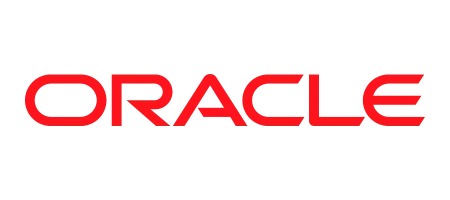
Oracle Financial Planning Software

Oracle is a Leader in this Magic Quadrant. Its product, Oracle Fusion Cloud Enterprise Performance Management, offers platform capabilities and packaged solutions for financial and operational planning, and related analytics and reporting. A key innovation is its IPM Insights and IPM predictions with AI to reduce analysis time, spot trends and anomalies, and improve forecast accuracy, which are useful resources for companies seeking faster, more accurate planning and enhanced data analysis.
Oracle’s ability to provide specialized solutions and initiatives tailored to the needs of the professional services industry, delivered either directly or through its partner network, is evident in its significant professional services client base. It also has representation across a broad spectrum of verticals.
Strengths
- Scenario modeling: Oracle offers advanced scenario modeling capabilities, including Monte Carlo simulations, M&A modeling, “grid pricing” for complex pricing, and treasury planning for share repurchase and loan repayments. Clients needing advanced scenario features can benefit from these capabilities, which provide probabilistic analysis to better predict outcomes and inform decision making in complex financial scenarios.
- Allocations: Oracle uses a no-code approach to develop complex cost allocations, offering advanced methodologies like activity-based and step allocations, with drillable end-to-end sources and validation. Clients looking for profitability analysis of different segments to guide strategic decisions benefit from this functionality, which supports self-service allocation models.
- AI investment: Oracle is heavily investing in generative AI capabilities, starting with features like GenAI narrative generation for management reports and advanced predictions. These innovations, backed by a detailed roadmap, will help early AI adopters enhance efficiency and accuracy in management reporting and planning.
Concerns
- Starter kits: Oracle’s industry-specific starter kits for financial planning software are designed to be used by implementation partners as a common starting point, often offered through their partner network. This can introduce variations in implementation and customization, making it challenging for customers to evaluate the strategic relevance of these kits. Customers with specific industry needs should carefully evaluate and compare the vendor’s starter kits against their requirements.
- Non-licensed report access: Oracle’s approach to delivering report distribution for non-licensed users via Excel, PDF and HTML lacks the flexibility of direct access to interactive reports and dashboards. Customers requiring flexible reporting for non-licensed users should consider these limitations and explore the vendor’s blended discounting model during selection.
- Formal response SLAs: While Oracle provides SLAs for uptime and has guidelines for responding to high-severity issues, it does not offer formal SLAs for overall support response times. User experiences with support can vary. Organizations concerned about support responsiveness should explore additional service options.

Pigmet Financial Planning Software

Pigment is a Visionary in this Magic Quadrant. Its product, the Pigment platform, offers cloud-based financial performance management with purpose-built applications. A key innovation is its flexible data model, which adapts over time, unifies data in real-time across applications and functions to reduce the risk of discrepancies, and supports advanced calculations and queries. These are helpful capabilities for clients seeking comprehensive data management and analytics.
Pigment’s ability to support users in scaling, resource allocation and profitability, helping companies drive investment decisions, is evident in its significant technology client base. Additionally, it focuses on select industries with specialized vertical emphasis.
Strengths
- Data integration: Pigment’s financial planning software automates data reconciliation and validation with automated data mapping, failure alerts, centralized data models that are connected in real time, and data quality boards. This ensures consistent and accurate financial information and supports IBP use cases. Clients with complex financial data environments can reduce manual errors and benefit from improved data quality.
- Product strategy: Pigment’s rapid delivery on roadmap enhancements provides functionality, such as its sparse data storage engine, customizable workflows and organization chart functionality. Clients seeking to enhance planning and collaboration will benefit from streamlined data management, optimized workflows and increased flexibility.
- Customer experience: Pigment maintains high standards and ensures successful outcomes through strict oversight of partner-led implementations. This includes a rigorous calibration process, mandatory project deliveries for certification maintenance, and comprehensive customer satisfaction surveys. Clients prioritizing high-quality implementations and partner accountability will benefit from this strategy
Concerns
- Customer support: Pigment provides standard support during business hours (EST and GMT). This may not be sufficient for organizations that operate globally or need support outside these hours. Critical issues are managed by 24/7 on-call systems, but the limited availability for standard support could impact response times and resolution.
- Predictive analytics: Pigment’s AI machine learning (ML) capabilities are still in beta testing and not yet generally available, limiting the product’s predictive capabilities at the time of this research. Clients seeking ML capabilities should evaluate these features in detail, as they are less mature.
- License-based access: Pigment’s financial planning software restricts access to reports and interactive dashboards to licensed users only, unlike some other vendors that offer distribution options to non-licensed users. Organizations that require widespread access must consider view only licenses for these users or export reports (e.g., .csv, .pdf) or data into a warehouse for distribution to non-licensed users.
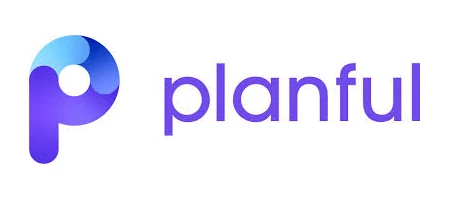
Planful Financial Planning Software

Planful is a Visionary in this Magic Quadrant. Its product, the Planful platform, offers financial performance management, planning, budgeting, forecasting and modeling, reporting and process automation. A key innovation is its use of AI and automation, including generative AI to streamline financial planning with advanced capabilities, offering organizations enhanced accuracy, reduced manual effort and actionable insights.
Planful’s ability to enhance supply chain coordination, manage production costs, and improve demand forecasting through advanced analytics is evident in its significant manufacturing client base. It also has representation across a broad spectrum of verticals.
Strengths
- Innovation: Planful balances new features with the needs of a range of planning personas. For instance, the recently released feature allows business users to test AI/ML prediction accuracy, while BYO model capabilities enable data scientists to perform advanced analytics. Clients seeking broad platform adoption will benefit from this strategy as it caters to both business users and data scientists.
- Solutions hub: Planful’s solution hub, categorized by industry and function, offers clients and partners access to preconfigured processes and industry-specific tools to speed up implementation. These accelerator solutions can expedite implementation and increase time to value for clients.
- Product development: Planful aligns new financial planning software features with market and customer needs by prioritizing inputs such as an AI co-innovation council, early-adopter programs and proactive market monitoring. Clients should join early-adopter programs and give feedback to shape features that address their unique challenges.
Concerns
- Partner capacity: Planful’s partner ecosystem, while expanding, includes a small number of partners compared to most vendors in the market. This may limit its ability to rapidly scale and support enterprise customers across diverse regions such as EMEA and APAC. Customers should assess partner availability and assess their regional and industry-specific capabilities directly to ensure they meet their needs.
- Predictive analytics: While Planful’s predictive engine includes external drivers such as exchange and interest rates, the market offers a wider range of native drivers. This may require organizations to rely more on their own AI/ML models for comprehensive predictive analytics. Clients should compare Planful’s external driver and predictive model offerings with market options to determine if customization is needed to meet their needs.
- Scenario modeling: Planful’s scenario modeling interface is less graphical and intuitive than some products with features such as side-by-side scenario comparison, with the ability to drill into scenario drivers. Potential customers should assess their scenario planning needs, compare alternatives, and consider user training to ensure the chosen tool meets their requirements
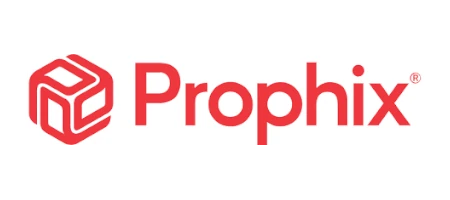
Prophix Financial Planning Software

Prophix is a Niche Player in this Magic Quadrant. Its product, Prophix One Financial Planning & Analysis, offers automated and integrated planning, budgeting and forecasting on a single platform. A key innovation is its unified portal for managing FP&A processes and improving productivity and data integration across workflows, which are desirable for clients seeking increased accuracy, speed and performance in their FP&A processes.
Prophix’s ability to help users drive decision making on sales and production, and support SKU-based budgeting for informed production and product decisions, is evident in its significant manufacturing client base. Additionally, it focuses on select industries with specialized vertical emphasis.
Strengths
- Product development: Prophix’s roadmap prioritization uses a structured reach, impact, confidence and effort (RICE) methodology, ensuring relevant strategic feature enhancements. Upcoming benefits include LLM pattern matching for transaction matching and budgeting, and ML modeler improvements for predictive forecasting. Customers should monitor these developments to maximize these evolving capabilities.
- Workflow automation: Prophix’s visual workflow and template builder support both list-based and drag-and-drop flow diagram approaches. This dual approach enhances productivity and adoption rates. Clients with manual, error-prone workflows will benefit significantly, especially through a pilot project.
- User experience: Prophix Pathways embeds user enablement within the platform, providing seamless movement between applications, guided onboarding and training experience, while the FP&A Advisor tool analyzes customer models and performance to suggest best practices. These features enable quick adoption and continuous model improvement. Clients prioritizing rapid adoption can leverage these tools to enhance user proficiency.
Concerns
- Starter kits: Prophix relies on partners for configuration and coding of industry-specific solutions, as it lacks direct starter kits and prebuilt solutions for most verticals. Potential customers with industry demands should assess the impact of these requirements on implementation timelines and costs, and plan for potential customization efforts to ensure a smooth deployment.
- Scenario planning: Prophix supports unlimited scenarios, rollback capabilities and the ability to combine scenarios. However, it lacks emerging scenario planning features such as Monte Carlo analysis, or provisioning of external drivers within the platform. Clients aiming for advanced analytics should evaluate these limitations to ensure they align with their strategic goals.
- Customer support: Prophix provides customer support during business hours in North America and Europe but lacks 24/7 support. Clients operating globally or requiring constant availability should evaluate how this limitation could affect their weekend and multi-time-zone planning needs.

SAP Financial Planning Software

SAP is a Leader in this Magic Quadrant. Its product, SAP Analytics Cloud, combines BI, planning capabilities and predictive analytics in one cloud environment. A key innovation is its combination of planning, forecasting and analysis with SAP applications, including finance, ERP, HR, sales and marketing, procurement, business network, and supply chain. This integration is advantageous for large enterprises in this market, as it enables comprehensive, data-driven decision making across various operational functions.
SAP’s ability to help clients manage product costs, streamline planning with SAP Integrated Business Planning, and monitor production efficiency is evident in its significant manufacturing client base; however, it also has representation across all major industries.
Strengths
- Deployment flexibility: SAP customers can select where their data is stored and which cloud provider to use before deployment. Options include global providers like AWS, Microsoft Azure, Google Cloud Platform, and AliCloud, as well as SAP’s own data centers. Customers with global availability concerns or compliance requirements may benefit from the ability to choose tenant locations.
- Data integration: SAP provides over 120 industry content packages, accelerating time-to-value for customers. The integration of SAP Analytics Cloud tools with SAP Datasphere’s business data fabric enhances connectivity with SAP and non-SAP data. Clients should consider their needs and evaluate how the combined use of these tools aligns with their goals and budget to fully leverage the enhanced connectivity.
- AI integration: The introduction of Joule, an AI assistant, showcases SAP’s market understanding by integrating seamlessly across all SAP applications and data. SAP’s vision for Joule is to aid in content development, data analysis, simulations and decision monitoring. Clients prioritizing user-centric solutions should evaluate what Joule will bring to determine how it can enhance user experience and productivity.
Concerns
- Datasphere investment option: While Datasphere provides advanced integration capabilities, its adoption may require additional investment and add complexity. Customers should evaluate the cost-benefit ratio of incorporating SAP Datasphere in their SAP strategy to ensure it aligns with their overall business goals and budget.
- Third-party reporting integration: SAP does not integrate via direct query with third-party analytics tools, requiring workarounds that add complexity (e.g., using APIs to move data to a data warehouse for analysis). Customers should assess if this complexity impacts decision making and explore additional support to streamline data access.
- Implementation length: SAP implementation timelines range from 3 to 14 months, which can be longer than some competitors. This extended timeline could delay the realization of benefits. Organizations pursuing a larger digital transformation, including multiple SAP products, or those with tight project schedules should evaluate these potential timelines and factor them into their implementation roadmap.

Strate Financial Planning Software

Strata (formerly Syntellis) is a Niche Player in this Magic Quadrant. Its product, Axiom, is an enterprise performance management software with tools for budgeting, forecasting, planning, reporting and scenario modeling. A key innovation is its Axiom Visual Insights, which merges complex and disparate datasets and offers self-service tools to build and edit data models and create visualizations. These features are valuable to organizations seeking to leverage their data for strategic growth.
Strata’s ability to integrate payer pricing data, leverage market data, and combine contract modeling with remit data through reimbursement insights is evident in its significant healthcare client base. Additionally, it focuses on select industries with specialized vertical emphasis.
Strata did not respond to requests for supplemental information or to review this report. Gartner’s analysis is therefore based on other credible sources.
Strengths
- Healthcare benchmarks: Strata collects and consolidates data from various business systems to offer users real-time healthcare benchmarks and KPIs, promoting data-driven decision making. Healthcare organizations should consider integrating these benchmark features to enhance strategic planning with targeted insights.
- Management insights and dashboards: Strata’s visual insights blend data from multiple sources to create interactive dashboards and reports, with features like decomposition trees and drag-and drop capabilities for custom visuals. Clients seeking to enhance collaboration and accelerate decision making should leverage these tools to identify business challenges and create tailored reports.
- Implementation partnership: Strata’s implementations are led by consultants with expertise in healthcare, higher education and financial institutions. They conduct collaborative scoping meetings with clients to develop a shared vision, fulfilling client needs, mitigating risks, and enhancing trust. Clients in these sectors should leverage Strata’s expertise for successful software implementations.
Concerns
- Predictive analytics: While Strata supports predictive analytics techniques like decision trees and neural networks, it lacks detailed confidence metrics or validation techniques to help users measure the accuracy and performance of their predictive forecasts. Customers relying on accurate predictive analytics should assess if Strata’s limitations in confidence metrics and validation techniques meet their forecasting needs.
- Starter kits: Strata’s starter kits and industry-specific solutions are primarily designed for the financial services and higher education sectors. Customers should evaluate whether these offerings align with their industry needs and consider any potential customization required, which could impact project timelines and costs.
- Language support: Strata’s software is only supported in four languages, with the majority of its customer base concentrated in North America. Customers planning global deployments should assess if the limited language support and regional focus align with their expansion goals and prepare for potential localization efforts.
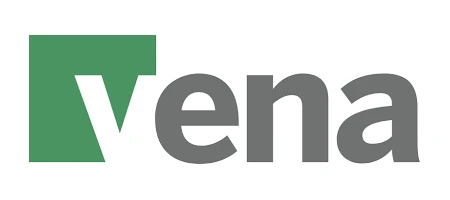
Vena Financial Planning Software

Vena is a Challenger in this Magic Quadrant. Its product, Vena Complete Planning, is a platform integrated with Microsoft 365 that offers AI, ML and BI capabilities with preconfigured solutions for various use cases. A key innovation is Vena Copilot’s use of natural language to gather data, generate reports and optimize forecasts, beneficial to organizations wishing to maintain familiarity with the Microsoft ecosystem while enhancing their planning efficiency and operational effectiveness.
Vena’s ability to support lag analysis reporting, S&OP, supply chain planning, bill of materials and demand planning is evident in its significant manufacturing client base; in addition, it also has representation across all major industries.
Strengths
- Management insights and dashboards: Vena offers self-serve reporting through Vena Insights, which enables dynamic and interactive data visualization with Power BI and AI features such as Microsoft’s Smart Narrative and Anomaly Detection. Clients aiming to integrate Power BI reporting capabilities with AI may benefit from this feature, as it allows them to stay within a familiar reporting environment.
- Microsoft partnership: Vena has a strategic partnership with Microsoft, which allows it to use extensive resources and technology to enhance productivity, operational efficiency and innovation. The relationship provides unique benefits to customers within the Microsoft ecosystem, such as seamless integration with familiar Microsoft tools like Office 365 and Power BI, to support them in streamlining workflows with a reduced learning curve.
- Pricing: Vena’s straightforward pricing model scales well with the number of users, offering substantial discounts for larger user bases. The approach makes it an attractive and cost-effective option for a wide range of organizations, providing both affordability and transparency, and helping build trust in the vendor, which can also support user adoption.
Concerns
- Geographic concentration: Vena’s operations are heavily concentrated in the United States, with limited European presence outside the United Kingdom. While it focuses on account-based engagement for marketing, expanding more of its local presence and regional partnerships outside of these regions could enhance customer confidence. Customers should evaluate Vena’s global reach and localized support relative to their business needs.
- Customer support: Vena offers limited support hours, with telephone and online chat support available 24/5 Monday through Friday. Its 24/7 telephone support is only available via its premium support offering. The support schedule may not meet the needs of all customers, particularly those requiring assistance outside standard business hours. This can lead to delays in issue resolution and adversely impact customer satisfaction.
- Allocations: While Vena has some level of capability for allocations, the ability to configure complex allocations (e.g., different methodologies and logic) requires customization. Customers with complex allocation needs should closely examine these capabilities and the level of configuration required

Wolters Kluwer Financial Planning Software

Wolters Kluwer is a Leader in this Magic Quadrant. Its product, CCH Tagetik, is an AI-based financial planning solution with real-time analysis, modeling and reporting, as well as data-enabled forecasts. A key innovation is its AI-powered Intelligent Platform to enhance data management and forecasting accuracy, helpful for organizations with complex financial operations and large datasets requiring high levels of accuracy and strategic insight.
Wolters Kluwer’s ability to support S&OP, profitability analysis, production cost planning and cash flow analytics, optimizing production and supply demands, is evident in its significant manufacturing client base; however, it also has representation across all major industries.
Strengths
- Capital planning: Wolters Kluwer provides capital planning with prebuilt logic, templates and integration with financial forecasting modules. Features like multiyear investment calculations, what-if analysis and drillable dashboards demonstrate a strong grasp of customers’ capital use cases. Clients prioritizing efficient capital management should evaluate the vendor’s out-of-the-box functionalities to accelerate their time to value.
- Starter kits: Wolters Kluwer provides an innovative acceleration ecosystem with a dedicated marketplace. It offers starter kits for nearly all industries, with a subset of industries augmented via partnerships as well. Customers across various industries should evaluate the vendor’s vertical starter kits to unlock faster time to value.
- Customer experience: Wolters Kluwer’s technical and business change request process includes PMO, customer service managers, design architects and implementation specialists. Gartner Peer Insights reviews indicate recognition of an outstanding customer experience. Clients can spend less time on contract changes and focus on higher-value decisions.
Concerns
- Partner recertification: Wolters Kluwer has voluntary partner recertification, which can create gaps in knowledge for certain partners that are not up to date on the latest product releases. Annual recertification is part of the vendor’s 2025 strategy. Clients relying on partner expertise should fully vet partner knowledge to ensure they are current on the latest product enhancements.
- Pricing: Wolters Kluwer’s pricing model includes essential functionality as part of the base package. As customers mature, operational and industry solutions are available as add-ons and require additional license fees and implementation charges. Clients looking to leverage vertical specific functionality should perform additional due diligence to fully understand the total cost of ownership, including licensing and implementation.
- Metadata management: Wolters Kluwer currently uses ETL and data virtualization techniques for metadata management, with data fabric capabilities planned for future implementation. Customers with varied data requirements, including unstructured data integration, should thoroughly assess the vendor’s data model to ensure its suitability.
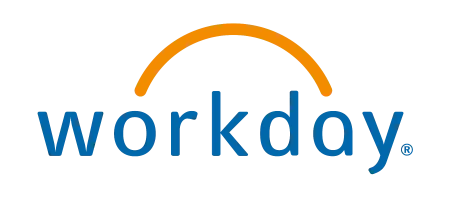
Workday Financial Planning Software

Workday is a Leader in this Magic Quadrant. Its product, Workday Adaptive Planning, is an enterprise planning and reporting platform that uses AI for driver-based planning, scenario modeling and analysis. A key innovation is its proprietary architecture, which enables complex financial modeling, high user concurrency and online design changes, valuable features for organizations needing robust and scalable solutions for financial modeling, planning and analysis.
Workday’s ability to help clients optimize project margins, utilization rates, billable hours and revenue forecasting is evident in its significant professional services client base; in addition, it also has representation across all major industries.
Strengths
- Performance monitoring: Workday’s Elastic Hypercube Technology design ensures platform performance across various planning solutions and offers in-model observability metrics for real time performance monitoring. This helps admins quickly identify and address issues, reducing time spent on performance problems. Clients seeking strong performance and monitoring across operational use cases should evaluate the benefits of the vendor’s design.
- Management insights and dashboards: Workday offers unlimited view-only user licenses at no additional fee that allow users to view reports and dashboards online. It offers data security configurations to control what users see, and ultimately offers a more secure and user-friendly approach to sharing information across the enterprise.
- Certified implementation: Workday uses certified partner resources across all phases, collaboratively mapping implementation activities with clients. Partners must recertify with each biannual product release, ensuring they remain up-to-date with the latest implementation best practices. Clients seeking additional confidence in the success of their implementation will find this recertification process valuable, as it facilitates smoother and more efficient project outcomes.
Concerns
- Predictive analytics: Workday provides built-in confidence metrics and tracks prediction accuracy over time; however, it lacks comprehensive event identification and prescriptive recommendations. This functionality is on the product roadmap, but customers requiring prescriptive recommendations should assess if current and proposed functionality provides sufficient visibility into forecasting accuracy.
- Data integration: Workday provides an embedded integration platform and a wide range of supported APIs, though it offers fewer prebuilt connectors than some vendors in the market. Users should evaluate if the available connectors and integration platform meet their data integration requirements.
- Intelligent assistance: While Workday offers in-context help within its application, it currently lacks intelligent features for natural language query support and personalized suggestions based on user activity. Organizations that prioritize 24/7 self-service support and an enhanced user experience should ask about the vendor’s roadmap for these features.
Vendors Added and Dropped
Gartner reviews and adjusts inclusion criteria for Magic Quadrants as markets change. As a result of these adjustments, the mix of vendors in any Magic Quadrant may change over time. A vendor’s appearance in a Magic Quadrant one year and not the next does not necessarily indicate that Gartner has changed their opinion of that vendor. It may be a reflection of a change in the market and, therefore, changed evaluation criteria, or of a change of focus by that vendor.
Added: Pigment met the inclusion criteria and was added.
Dropped: Acterys no longer appears in this Magic Quadrant report because it did not meet the inclusion criteria
for the Customer Interest Indicator.
Inclusion and Exclusion Criteria
Vendor solutions must align with the earlier market definition and successfully adhere to Gartner’s standard cloud service attributes as defined below.
To be considered for inclusion, a vendor must meet the specified market presence criteria, performance criteria and product capabilities. Furthermore, they must offer the solution on the cloud, adhering to the definition provided in the exclusion criteria.
Market Presence
The vendor must meet all of the following criteria for their financial planning software:
- Actively market and sell products to organizations with at least 50% of customers having annual revenue above $50 million over the last year. The definition of a customer is a single legal entity paying for stand-alone financial planning software.
- Have at least 250 customers “live” by 31 March 2024 and market to “live” customers in at least two regions across America, EMEA, Asia/Pacific or Latin America. (“Live” is defined as the customers that are on the current SaaS version of the product as defined in the market definition, and are in production.)
- The vendor must rank among the top 16 for the Customer Interest Indicator (CII) as defined by Gartner for this Magic Quadrant. The CII was calculated using a weighted mix of internal and external inputs that reflect Gartner client interest, vendor customer engagement and vendor customer sentiment from March 2023 to February 2024.
Performance Criteria
The provider must meet either of the following conditions:
- Have booked cloud recurring subscription and support revenue of at least US$30 million (or foreign currency equivalent) between 31 March 2023 and 31 March 2024.
- Revenue must come from stand-alone technology sales to financial planning software customers only, and not from other products, other indirect sales channels like resellers, distributors or other applications who then sell the product to their own customers or embed the vendor’s product within their offering.
- Revenue from services, implementation fees or any adjacent modules beyond the market definition specified above should not be included.
Or
- Revenue generated from financial planning software should meet a minimum compounded annual growth rate of 20% between the years 2021 and 2023.
Product Capabilities
To qualify for inclusion, providers need to meet the following:
- Support the mandatory financial planning software features as defined in the Market Definition section.
- Deploy financial planning software as a cloud-based solution via software as a service (SaaS) on a provider-managed public or private cloud.
- Must have released its financial planning software for general availability before 31 December 2022, and be actively sold on a stand-alone basis, independent of other offerings or service.
Exclusion Criteria
This Magic Quadrant excludes vendor’s on-premises-only solutions and any cloud solutions that do not meet the following cloud service attributes:
- Hosts within the vendor’s or a third-party public cloud environment (e.g., AWS, Google Cloud Platform, Microsoft Azure).
- Implements upgrades directly as part of the cloud service, not through a third party or managed service provider.
- Licenses the cloud service on a subscription or metered pay-for-use basis.
- Prohibits modification of its source code. Configuration via citizen developer tools and extension via platform as a service (PaaS) — by partner, vendor or user — is allowed.
- Uses a single code line for all customers of the cloud service, to enable rapid deployment of new functionality by the vendor.
- Offers self-service provisioning capabilities for the software (at least for development and test instances) without requiring involvement of the vendor.
Evaluation Criteria
Ability to Execute
Gartner evaluates vendors by assessing their product’s services, sales and marketing execution, and overall operations. Analysts evaluate how these criteria enable the vendors to be competitive and effective in the market, support their ability to satisfy customers, assist in creating positive perception and help them adequately respond to market changes.
In this Magic Quadrant, the product or service, customer experience and market responsiveness criteria are particularly important:
- Product or service encompasses the vendors’ ability to deliver current capabilities, high quality, comprehensive feature sets and expertise, with a strong emphasis on functionality that enhances financial planning and decision-making processes for end users.
- Customer experience evaluates the vendor’s capacity to deliver a journey that enables clients to succeed with the product or service.
- Market responsiveness ensures vendors can rapidly adjust their software to address the evolving needs of FP&A leaders, enabling them to offer innovative solutions that enhance decision making, strategic planning, performance management and resource allocation.
Table 1: Ability to Execute Evaluation Criteria
Product or Service: High
Overall Viability: Medium
Sales Execution/Pricing: Medium
Market Responsiveness/Record: High
Marketing Execution: Low
Customer Experience: High
Operations: Low
Completeness of Vision
Gartner assesses vendors by evaluating their ability to articulate their perspectives on the market’s current and future direction, to anticipate customers’ needs and technology trends, and to address competitive forces. Analysts also evaluate Completeness of Vision by vendors’ understanding and articulation of how they exploit market forces to create new opportunities for themselves and their clients.
In this Magic Quadrant, market understanding, offering strategy, and innovation are also particularly important:
- Market understanding focuses on the vendor’s ability to understand and anticipate future buyers’ requirements and needs.
- Offering strategy involves using the information gathered about future buyers’ requirements and needs to shape or enhance the products and services offered.
- Innovation enables vendors to develop cutting-edge solutions that not only meet current demands but also anticipate future trends, providing FP&A leaders with tools that enhance efficiency, accuracy and strategic foresight.
Table 2: Completeness of Vision Evaluation Criteria
Market Understanding: High
Marketing Strategy: Low
Sales Strategy: Low
Offering (Product) Strategy: High
Business Model: Medium
Vertical/Industry Strategy: Medium
Innovation: High
Geographic Strategy: Medium
Quadrant Descriptions
Leaders
Leaders demonstrate a market-defining vision of how financial planning software can help FP&A leaders achieve their objectives of enhancing planning, budgeting and forecasting while integrating advanced analytics and AI capabilities. They are in the strongest position to influence the market’s direction and provide mature offerings that meet market demand.
Leaders have a deep understanding of the market, a reliable track record, and the ability to attract and retain customers. They consistently expand functionality, adding new products and services to their core offerings, such as ESG planning, data integration, master data management (MDM) and data quality. Their unified platforms enable integrated planning, budgeting and forecasting across various functions, enhancing data governance and accuracy. Leaders spearhead innovative ways to integrate AI/ML into planning processes through diverse use cases such as predicting revenue trends based on historical data and AI-driven scenario models to forecast future cash inflows and outflows, thereby enhancing liquidity planning. They instill user confidence in predictive forecasts, advanced scenario models and AI-driven recommendations with explainability features like confidence levels and statistics.
Leaders consistently win new deals, servicing customers across various geographies, industry verticals and organization sizes. They provide tailored solutions to meet unique industry needs, including innovative ecosystems with dedicated marketplaces for industry-specific solutions and starter kits. They effectively use partners, such as systems integrators, consulting firms and technology collaborators, in product development, sales, marketing and customer implementation efforts.
Challengers
Challengers exhibit strong execution and product capabilities that address their clients’ diverse planning needs by offering customizable solutions that automate workflows and data processing. They have established credibility in the market, provide sufficient customer support and have developed market recognition for their financial planning software products. They also have a proven ability to win deals and are well-placed to succeed in the market.
Challengers work directly with clients to co-create implementation strategies, provide reengineered models to enable faster implementation and extend their functionality across platforms to support end-user adoption. They provide adequate customer experiences through formal service processes and service-level agreements, demonstrating an understanding of clients’ current financial planning goals.
Though Challengers exhibit strong execution capabilities and their available product features meet customer needs, their vision and roadmap are limited. They primarily focus on enhancing established core areas such as planning, budgeting and forecasting, rather than introducing leading or groundbreaking features. While their products meet basic functionality, this narrower focus results in less innovation compared to Leaders and Visionaries.
Challengers may suit organizations prioritizing execution through established product and support practices over product innovation. FP&A leaders should assess Challengers based on their current capabilities and gaps, considering how these gaps might impact their near-term goals for achieving higher levels of future FP&A maturity.
Visionaries
Visionaries demonstrate a leading vision and robust roadmap by incorporating AI/ML technology and curating a portfolio of relevant patents tailored to financial planning software. They invest heavily in research and development, and collaborate with industry experts and thought leaders to continuously refine their strategies. Visionaries align their approaches with emerging trends that are currently shaping or are expected to shape the financial planning software market, emphasizing the delivery of innovative software enhancements. This includes a strong focus on workflow automation and personalized, user-specific customization, showcasing their commitment to advancing their product capabilities.
Their roadmap includes leading innovations, such as the introduction of a large language model (LLM), that enhances natural language processing capabilities, enabling more intuitive user interactions and advanced data analysis. Additionally, they provide customized algorithms designed to address unique or complex situations, ensuring tailored solutions for specific business needs. The synchronization of disparate planning stakeholders further demonstrates their commitment to cohesive and collaborative planning processes. This comprehensive approach showcases their leadership and forward-thinking strategy within the financial planning software market.
Though Visionaries exhibit a strong and differentiated vision, they are limited in terms of market presence and execution or track record. Their customer base and operations are often concentrated in specific geographies, and they may lack industry-specific starter kits or solutions to support certain sectors.
Visionaries may be an appropriate choice for organizations that want innovation from a vendor who does not yet have a significant presence in the market. This may offer a competitive advantage or a chance to influence the vendor’s product roadmap. However, given the comparatively limited market presence of Visionaries, organizations evaluating these providers should closely assess their ability to meet execution requirements for specific regions and industries.
Niche Players
Niche Players excel within specific segments or subsegments of the market but often lack the broad vision and innovative capabilities necessary to keep pace with competitors in the wider market. While they may demonstrate innovation within their specific vertical, geography or functionality, they typically lack comprehensive attributes such as a deep market understanding and a well-defined product strategy. Their approach is often not as holistic, failing to integrate either vertical or geographic aspects of their offering effectively.
Niche Players present a compelling product tailored to address specific needs within a distinct set of buyers. They enhance customers’ planning processes with features such as industry-specific benchmarking and APIs for specialist niche source systems.
They emphasize a customer-driven approach in their strategies. This includes offering services such as in-house implementations by industry specialists — professionals with extensive knowledge and expertise in specific fields — along with visual insights and reporting. They also maintain competitive and transparent pricing. Their operations, marketing and sales strategies are concentrated on a particular subsegment of the market. However, their capacity to consistently secure new business across diverse regions or industries may be less proven compared to vendors in other quadrants.
Although potential customers might assume vendors in the other quadrants are better choices for their financial planning needs, Niche Players can be a good choice in certain circumstances. This is because they might focus on a specific capability, organization size, complexity, geography or industry vertical relevant to particular users. FP&A leaders evaluating Niche Players must understand these vendors’ geography and solution focus to see how well they align with user functional objectives.
Context
With the advancement of cloud-based financial planning software and analytics capabilities, access to a wider range of data sources has become possible. This includes transactional, operational and external data, with some use cases even providing real-time data.
The expansion of data sources enables FP&A leaders to better support a more comprehensive scope of financial and operational planning needs. However, this expansion requires new investments in technology and infrastructure that best suit current and future organizational needs. Additionally, the inclusion of AI capabilities such as predictive analytics, and the evolution of NLP-driven insights and confidence metrics empower FP&A leaders to deliver more enhanced data-driven decision-making capabilities to their organizations.
The following are key considerations and recommendations for assessing vendors that are best suited to meet buyers’ needs.
Investigate implementation strategy and support:
- Assess the existing technology portfolio and how that technology stack would best integrate with the financial planning software.
- Investigate the structure of vendor involvement in partner-led implementations and the mechanisms in place to ensure vendor oversight and success.
- Evaluate each vendor’s prebuilt connectors to ERPs, CRMs and accelerators/templates (i.e., preconfigured tools to expedite implementation and integration), and vendors’ typical implementation time frames and costs.
- Determine the experience and support each solution provider has within the region and the specific technology ecosystems of the vertical.
Explore the differentiating features and vendor roadmaps:
- Understand that product development features and roadmaps differ between vendors.
- Ensure the selected vendor is focused on product development solutions that align with your organization’s expectations and future needs.
- Evaluate vendors’ current and future advanced analytics capabilities, such as their investments in AI and ML, external data integrations, scenario planning, alternate hierarchy support, workflow automation and collaboration functionalities.
Examine the pricing models:
- Recognize that vendors in this market have pricing models mainly driven by user type, user volume or add-on support services. Features such as specialized AI capabilities, additional workspace beyond allocated limits and advanced ML functionalities might incur additional costs based on the vendors’ pricing models.
- Evaluate which model is best based on the organization’s current and future growth projections.
Market Overview
Today’s FP&A transformation efforts focus on optimizing financial planning processes amid complex operations and diverse, decentralized ERP and operational systems. Organizations are increasingly seeking efficient, agile planning and management to respond to market changes, aiming for planning software that extracts on-demand, value-added insights to help identify risks and opportunities crucial for driving financial value across the enterprise. In response, vendors are developing advanced financial planning software features, commonly deployed as SaaS cloud offerings with subscription-based pricing.
Market Trends
Generative AI and Advanced Analytics
Generative AI and advanced analytics are transforming financial planning software by automating repetitive tasks, enhancing forecasting accuracy and democratizing access to sophisticated data insights. These advancements enable finance teams to produce more reliable forecasts, generate branded research reports through natural language input and detect anomalies in real time, improving productivity and decision-making speed. The integration of AI and ML capabilities can allow users without extensive data science expertise to leverage these tools.
Enhanced Data Integration and Connectivity
Seamless data integration and connectivity are critical for financial planning solutions, enabling organizations to streamline data management and ensure data accuracy across platforms. Vendors are enhancing their offerings with features like Open Business Data Fabric, integrations with OneDrive and SAP HANA, and reengineered in-memory cube architectures. These capabilities allow for larger and more complex datasets, reducing the need for manual data handling and improving overall data consistency.
These solutions make it easier for users to connect disparate data sources, enhancing the comprehensiveness and reliability of their financial analyses. Advanced interoperability with analytics and business intelligence (ABI) tools allows organizations to establish a unified reporting strategy. This integration leverages preferred tools to create reports and dashboards that incorporate both financial and nonfinancial data. Write-back capabilities through tools like Power BI enable seamless updates and increased user adoption. Write-back refers to the ability of users to make changes or updates directly within the ABI tool, such as Power BI, and have those changes automatically reflected back into the original data source or system.
Collaboration and Connected Planning Across Functions
Improving user experience and fostering collaboration are key focuses. Vendors are investing in features like enhanced workflows, new user interfaces, personal what-if scenarios and natural language data interaction tools. These innovations make the software more intuitive and user friendly, increasing user adoption and engagement.
There is a significant push toward connecting finance with operational functions to enable more comprehensive and integrated business planning. Enhanced collaboration tools support better coordination among team members, leading to more efficient planning processes. These features also help users monitor and optimize their planning models effectively, driving performance improvements and ensuring all stakeholders are aligned.
Acronym Key and Glossary Terms
AI: Artificial intelligence
API: Application programming interface
BI: Business intelligence
BPO Business process outsourcing
CPG: Consumer packaged goods
CRM: Customer relationship management
DAX: Data Analysis Expressions
EMEA: Europe, the Middle East and Africa
ERP: Enterprise resource planning
ESG: Environmental, social and governance
FP&A: Financial planning and analysis
GenAI: Generative artificial intelligence
IBP: Integrated business planning
JDBC: Java Database Connectivity
KPI: Key performance indicator
LLM: Large language model
M&A: Mergers and acquisitions
ML: Machine learning
MDM: Master data management
NLP: Natural language processing
OData: Open Data Protocol
ODBC: Open Database Connectivity
PA: Planning Analytics
RACI: Responsible, accountable, consulted and informed
REST APIs: Representational State Transfer Application Programming Interfaces
S&OP: Sales and operations planning
TM1: Table Manager 1
WCAG: Web Content Accessibility Guidelines
Evaluation Criteria Definitions
Ability to Execute
Product/Service: Core goods and services offered by the vendor for the defined market. This includes current product/service capabilities, quality, feature sets, skills and so on, whether offered natively or through OEM agreements/partnerships as defined in the market definition and detailed in the subcriteria.
Overall Viability: Viability includes an assessment of the overall organization’s financial health, the financial and practical success of the business unit, and the likelihood that the individual business unit will continue investing in the product, will continue offering the product and will advance the state of the art within the organization’s portfolio of products.
Sales Execution/Pricing: The vendor’s capabilities in all presales activities and the structure that supports them. This includes deal management, pricing and negotiation, presales support, and the overall effectiveness of the sales channel.
Market Responsiveness/Record: Ability to respond, change direction, be flexible and achieve competitive success as opportunities develop, competitors act, customer needs evolve and market dynamics change. This criterion also considers the vendor’s history of responsiveness.
Marketing Execution: The clarity, quality, creativity and efficacy of programs designed to deliver the organization’s message to influence the market, promote the brand and business, increase awareness of the products, and establish a positive identification with the product/brand and organization in the minds of buyers. This “mind share” can be driven by a combination of publicity, promotional initiatives, thought leadership, word of mouth and sales activities.
Customer Experience: Relationships, products and services/programs that enable clients to be successful with the products evaluated. Specifically, this includes the ways customers receive technical support or account support. This can also include ancillary tools, customer support programs (and the quality thereof), availability of user groups, service-level agreements and so on.
Operations: The ability of the organization to meet its goals and commitments. Factors include the quality of the organizational structure, including skills, experiences, programs, systems and other vehicles that enable the organization to operate effectively and efficiently on an ongoing basis.
Completeness of Vision
Market Understanding: Ability of the vendor to understand buyers’ wants and needs and to translate those into products and services. Vendors that show the highest degree of vision listen to and understand buyers’ wants and needs, and can shape or enhance those with their added vision.
Marketing Strategy: A clear, differentiated set of messages consistently communicated throughout the organization and externalized through the website, advertising, customer programs and positioning statements.
Sales Strategy: The strategy for selling products that uses the appropriate network of direct and indirect sales, marketing, service, and communication affiliates that extend the scope and depth of market reach, skills, expertise, technologies, services and the customer base.
Offering (Product) Strategy: The vendor’s approach to product development and delivery that emphasizes differentiation, functionality, methodology and feature sets as they map to current and future requirements.
Business Model: The soundness and logic of the vendor’s underlying business proposition. Vertical/Industry Strategy: The vendor’s strategy to direct resources, skills and offerings to meet the specific needs of individual market segments, including vertical markets.
Innovation: Direct, related, complementary and synergistic layouts of resources, expertise or capital for investment, consolidation, defensive or pre-emptive purposes.
Geographic Strategy: The vendor’s strategy to direct resources, skills and offerings to meet the specific needs of geographies outside the “home” or native geography, either directly or through partners, channels and subsidiaries as appropriate for that geography and market.